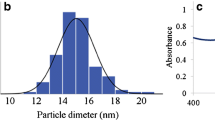Abstract
A new, simple, inexpensive, and rapid 96-well plate UV spectrophotometric method was developed and validated for the quantification of compound 48/80 (C48/80) associated with particles. C48/80 was quantified at 570 nm after reaction with acetaldehyde and sodium nitroprusside in an alkaline solution (pH 9.6). The method was validated according to the recommendations of the ICH Guidelines for specificity, linearity, range, accuracy, precision, and detection and quantification limits (DL and QL). All the validation parameters were assessed in three different solvents, i.e., deionized water, blank matrix of chitosan nanoparticles, and blank matrix of chitosan/alginate nanoparticles. The method was found to be linear in the concentration range of 5 to 160 μg/ml (R 2 > 0.9994). Intraday and interday precision was adequate, with relative standard deviation lower than those given by the Horwitz equation. The mean recoveries of C48/80 from spiked samples ranged between 98.1% and 105.9% for calibration curves done with the blank matrices and between 89.3% and 103.3% for calibration curves done with water, respectively. The DL were lower than 1.01 μg/ml and the QL were lower than 3.30 μg/ml. The results showed that the developed method is sensitive, linear, precise, and accurate for its intended use, with the additional advantages of being cost-effective and time-effective, allowing the use of small-volume samples, and the simultaneous analysis of a large number of samples. The proposed method was already successfully applied to evaluate the loading efficacy of C48/80 chitosan-based nanoparticles and can be easily applied during the development of other C48/80-based formulations.


Similar content being viewed by others
REFERENCES
Rothschild AM. Mechanisms of histamine release by compound 48–80. Br J Pharmacol. 1970;38(1):253–62.
McLachlan JB, Shelburne CP, Hart JP, Pizzo SV, Goyal R, Brooking-Dixon R, et al. Mast cell activators: a new class of highly effective vaccine adjuvants. Nat Med. 2008;14(5):536–41.
Staats HF, Fielhauer JR, Thompson AL, Tripp AA, Sobel AE, Maddaloni M, et al. Mucosal targeting of a BoNT/A subunit vaccine adjuvanted with a mast cell activator enhances induction of BoNT/A neutralizing antibodies in rabbits. PLoS One. 2011;6(1):e16532.
McGowen AL, Hale LP, Shelburne CP, Abraham SN, Staats HF. The mast cell activator compound 48/80 is safe and effective when used as an adjuvant for intradermal immunization with Bacillus anthracis protective antigen. Vaccine. 2009;27(27):3544–52.
Wang SH, Kirwan SM, Abraham SN, Staats HF, Hickey AJ. Stable dry powder formulation for nasal delivery of anthrax vaccine. J Pharm Sci. 2012;101(1):31–47.
Vajdy M, Srivastava I, Polo J, Donnelly J, O’Hagan D, Singh M. Mucosal adjuvants and delivery systems for protein-, DNA- and RNA-based vaccines. Immunol Cell Biol. 2004;82(6):617–27.
Paton WD. Compound 48/80: a potent histamine liberator. Br J Pharmacol Chemother. 1951;6(3):499–508.
Lin CM, Wagner C. Quantitative determination of secondary amines: measurement of N-methylalanine. Anal Biochem. 1974;60(1):278–84.
Cullis CF, Waddington DJ. The colorimetric determination of secondary amines. Anal Chim Acta. 1956;15:158–63.
O’Neal CL, Crouch DJ, Fatah AA. Validation of twelve chemical spot tests for the detection of drugs of abuse. Forensic Sci Int. 2000;109(3):189–201.
Gan Q, Wang T. Chitosan nanoparticle as protein delivery carrier—systematic examination of fabrication conditions for efficient loading and release. Colloids Surf B Biointerfaces. 2007;59(1):24–34.
Rajaonarivony M, Vauthier C, Couarraze G, Puisieux F, Couvreur P. Development of a new drug carrier made from alginate. J Pharm Sci. 1993;82(9):912–7.
ICH Harmonized Tripartite Guideline. Validation of analytical procedures: text and methodology Q2(R1). 2005.
Huber L, editor. Validation and qualification in analytical laboratories. 2nd ed. New York: Informa Healthcare; 2007.
Taverniers I, De Loose M, Van Bockstaele E. Trends in quality in the analytical laboratory. II. Analytical method validation and quality assurance. TrAC Trends Anal Chem. 2004;23(8):535–52.
Ermer J, Burgess C, Kleinschmidt G, McB. Miller JH. Performance parameters, calculations and tests. Method validation in pharmaceutical analysis. Weinheim: Wiley-VCH; 2005. p. 21–194.
Thompson M, Ellison SLR, Wood R. Harmonized guidelines for single-laboratory validation of methods of analysis (IUPAC technical report). Pure Appl Chem. 2002;74:835–55.
Eurachem. The fitness for purpose of analytical methods: a laboratory guide to method validation and related topics. http://www.eurachem.org/guides/pdf/valid.pdf (1998).
ACKNOWLEDGMENTS
This study was financially supported by the Portuguese Foundation of Science and Technology (FCT), grant SFRH/BD/65141/2009, and project FCT PTDC/SAL-FAR/115044/2009.
Author information
Authors and Affiliations
Corresponding author
Rights and permissions
About this article
Cite this article
Bento, D., Borchard, G., Gonçalves, T. et al. Validation of a New 96-Well Plate Spectrophotometric Method for the Quantification of Compound 48/80 Associated with Particles. AAPS PharmSciTech 14, 649–655 (2013). https://doi.org/10.1208/s12249-013-9950-4
Received:
Accepted:
Published:
Issue Date:
DOI: https://doi.org/10.1208/s12249-013-9950-4




